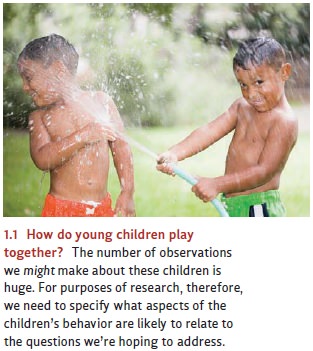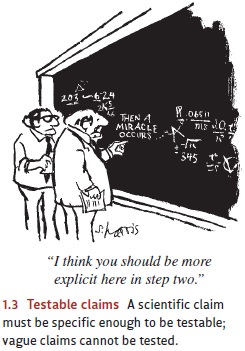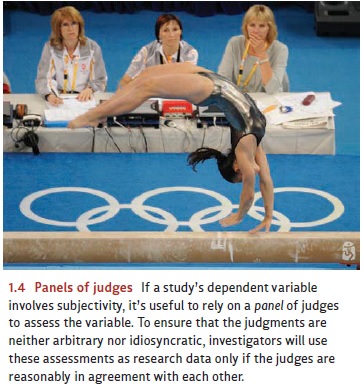Chapter: Psychology: Research Methods
Making Observations: Defining the Question
Defining the
Question
Science begins with
observation—but what should we
observe? If we are interested in, say, how young children play together (Figure
1.1), it’s just not possible to observe every-thing about their playtime. Everything (if interpreted literally)
would include each child’s every blink, every breath she takes, every time she
scratches her ear or touches her hair, and much, much more. A lot of this
information is unlikely to be of interest to our study, and so we’d be buried
under an avalanche of unnecessary details that might make us lose track of the
more useful information.

It seems, therefore, that we need
to choose which aspects of the children’s behavior we care about and which
aspects we can ignore. In making this choice, we’re usually guided by the questions we hope to address through our
observations: Is a child’s behav-ior influenced by the size of her playgroup?
If so, we need to count how many children are involved in the group. Does the
weather shape the child’s style of play? To find out, we’d need to note the
weather and somehow describe the “style.”
Moreover, it’s not enough just to
have a question. We also need to formulate the question in a way that leaves no
doubt about how we’re going to link the question to the evidence we collect. To
make this idea concrete, imagine that we wanted to ask: Which sex is more
aggressive in its playtime—boys or girls? In tackling this issue, we’d need to
be clear from the start about what sorts of actions would count as
“aggres-sive.” Otherwise, we might observe children for hours and still have no
way to answer our question.
This requirement to be specific
is usually met by making sure that any research project begins with a testable hypothesis—a specific claim about the facts, framed in a way that will allow
an unambiguous test. Testability, in
turn, is guaranteed by ensur-ing that the hypothesis is falsifiable—stated so that we’re clear at the start about what
pattern in the evidence could show the hypothesis to be false.
We can see how important these
ideas are by considering hypotheses that are not testable. Think about the forecasts that astrologers offer
(Figure 1.2)—for example, “There will soon be major changes in your life.” This
prediction is open-ended in ways that prevent any linkage to specific
observations: What exactly is meant by soon,
or major changes? There’s plenty of
room for debate about how these terms should be defined, and so there’s room
for debate about what sorts of observations would or wouldn’t falsify the
forecast. As a result, we have no way to check the forecast against the facts,
no way to tell if the claim is right or wrong. For scientific purposes, this
situation is unacceptable.

This example also makes it clear
that a testable hypothesis requires well-defined terms (Figure 1.3). To see how
this plays out, let’s press on with the question about whether the sexes differ
in their aggression on the playground. To address this question, we’ll need to
develop an operational definition—
one that translates (“operationalizes”) the variable we want to assess
(aggres-sion) into a specific procedure or measurement. We’ll also need the.

operational definition to have construct validity—that is, it must
truly reflect the variable named in our hypothesis. Thus, for example, we
wouldn’t operationalize aggression on the basis of how often someone frowns.
This wouldn’t be valid, because sometimes peo-ple frown for reasons other than
aggression and sometimes they don’t frown when they’re being aggressive. So it
would be better to operationalize aggression as a count of actions like kicks,
punches, and bites. This would count as an operationalization because these
behaviors can be directly observed in the data.
These points about
operationalization and validity are concerns about how we define our dependent variable—so called because
the investigator usually wants to find out whether changes in this variable depend on some other factor. In our
case, we want to know whether a child’s aggression levels depend—at least
partly—on his or her sex; so the dependent variable would be our measure of
aggression. The independentvariable, in
contrast, is the factor whose effects we hope to examine. If we’re askinghow
boys and girls differ in their aggression, then we have a single independent
variable—sex—that can take either of two values (male or female).
In many studies, the dependent
variable is operationalized in terms that can be eas-ily and objectively
measured. If, for example, we’re measuring someone’s memory capac-ity, our
dependent variable might be the percentage of correct answers on some test. If
we’re studying how sensitive someone’s hearing is, we might count the number of
faint tones that person can detect. A quality like aggression, though, might
require a differ-ent sort of yardstick because deciding whether an act is
aggressive can be a subjective matter. (Was that shove playful, or was it a hostile
push? Was that kick deliberate, or just an accident?) In dealing with this
subjectivity, our best option is to use a panel of judges who assess the
study’s participants on the relevant dimension. We could, for example,
videotape the children at play and then show the recording to the judges. They
would rate each child’s aggression on, say, a 7-point scale where a rating of 1
means “not at all aggressive,” and 7 means “extremely aggressive.”
By using a panel of judges, we
can check on the subjectivity of the assessment (Figure 1.4). If a child’s play
seems aggressive to one judge but not to another, it confirms the concern that
this is a subjective matter. In that case, we can draw no conclusions from the
study; we’ll need to find some other way to measure our dependent variable. But
if the judges agree to a reasonable extent, then we can be confident that their
assessments are neither arbitrary nor idiosyncratic—and this would allow us to
use the results of judges’ assessments as the study’s dependent variable.

Related Topics